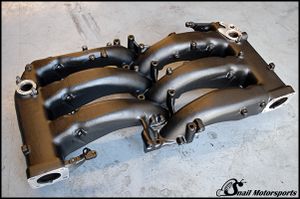Intake Manifold
The Intake Manifold (sometimes called the plenum) is the main collector for the VG30DE(TT)'s intake system.
Function
The intake manifold houses the throttle bodies which vary the amount of air entering. It also carries the task of distributing air evenly to each cylinder, and providing vacuum signal for various auxiliary components.
A great deal of effort was focused on the design of the intake manifold, especially in the shape of its intake runners. The following excerpt from AutoSpeed'sarticle on the VG30DETT explains:
The intake system design had to balance two opposing outcomes:
- the smaller that the intake runner diameters were made, the greater the frictional losses (and so pressure drops)
- but the larger the intake runner diameters, the slower the airflow speed, resulting in a decrease in cylinder filling, especially at low rpm
In addition, simulation and testing showed that long intake runners resulted in better torque development at low engine revs - however, fitting long runners into an already crowded engine bay was going to be difficult. Runners that were 360mm long gave peak intake efficiency at 4400 rpm, while lengthening these to 480mm dropped the peak intake efficiency revs to 3600 rpm. Since one of the goals of the engineers was strong bottom-end torque, the longer runners became a requirement. Further testing showed that a runner diameter of 48mm worked well with the 480mm long design.
[It's interesting to note the major amount of development that occurred in tuning the intake system in this turbocharged engine. Many turbo engines - including Nissan's own RB26DETT Skyline GT-R engine - have no intake resonance tuning at all.]
Once 480mm (nearly 19 inch!) long intake runners had been decided upon, the next question was how they'd be fitted under the bonnet. The previous model VG30DE had placed the plenum chamber centrally on top of the V6, with relatively short but direct runners connecting the plenum to the intake valves. The measured pressure drop with this arrangement was 85 units.
[The units used are not completely clear - they may be mm of water at 4.4 cubic metres/minute flow.]
The first prototype VG30DETT intake system design placed a plenum chamber above each bank of cylinders, with the intake runners for that head connected to the plenum above it. This required that each runner go through nearly a U-turn, and so was called the 'U-turnport' design. The pressure drop of this design was, however, very high - being measured at 105 units, or nearly 24 per cent higher than the original VG30DE design with the centrally-located plenum chamber.
A 'crossport' design was then built, where the plenum chamber feeds the opposite cylinder bank. This design allowed the retention of the long intake runners but gave a measured pressure drop of only 80 units - better than the VG30DE design, despite the use of intake runners nearly twice as long. The change from a U-turnport to a crossport design resulted in a 5 per cent increase in peak power.
The intake system ahead of the intake manifold was also extensively developed. The airfilter housing used two filtering elements to provide sufficient filtering area within the tight confines of the engine bay. Only a single airflow meter was used, but the junction where the duct splits to feed each turbo was extensively developed. The final design used a very long radius inner bend reducing measured pressure drop by 77 per cent over some of the designs trialled. Together with the use of a bellmouth at the entrance to the airflow meter, these flow improvements increased peak power by 2 per cent.
Versions
There are two versions of the intake manifold used on the 300ZX, Phase I and Phase II.
| |
Non-Turbo |
NA (Convertible) |
Twin Turbo |
| Phase I |
1990-1992 |
1993 |
1990-1994 |
| Phase II |
1993-1996 |
1994-1996 |
1995-1996 |
Phase I and Phase II manifolds are interchangeable. The only difference between the two are throttle spring cover mounting points on the Phase II manifolds. The Z32 never actually came with such covers, but the Infiniti J30 did (which used the same intake manifold as the P2 Z32).
NA and TT manifolds are also identical; the only differences being the port fittings and balance tube attached to the manifold. The same holds true for RHD and LHD Zs.
Removal
See article: Intake Manifold Removal.
